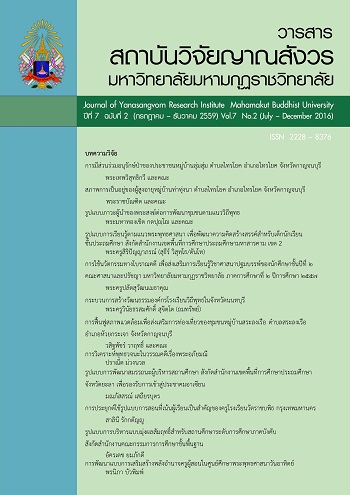Community Participation toward Community Capability Development in Addictive Substance Use Problem Solving
Main Article Content
Abstract
The purpose of this community action research (CAR) is to study community participation toward community capability development in addictive substance using problem solving. The conceptual frameworks are community capability participation and participatory rural appraisal (PRA). The data was collected from observation, recording community operation and interviewing the participants. The period of the study was 6 months. The findings were as follows: 1. The community context study for a strong and capable community indicated that community is good relationship, helpfulness and a good culture and custom, a capable leader and the community did not have system and mechanism in addictive substance using problem solving. There are plenty of resources in the community; physical geography, economy, socio-cultural community, environment and management toward community capability development leading to participate in finding on appropriate problem solving and guidelines. These lead to make a community planning and solve the problems appropriately. 2.The study of community participation toward community capability development in addictive substance using problem solving through 3 phases were 1) a common goal by community meeting to create the understanding, goal in common. The study reveals that the most important problem is a addictive substance using follow by a low income and the goal of the community is a well-being and moral community 2) contribution of structure/a basic mechanism to develop a learning community found that the strengths of the community are a good leader; sacrificial, generous, principled and harmonious person follow by the groups both specific and permanent groups. The weaknesses of the community are drinking in adult people which bad behavior toward children. 3) making a community action plan to develop community capability indicated that the community can analyze and prioritize the issue. The addictive substance using problem is the urgent problem to be solved consequently by 5 projects are established. 3. The development of addictive substance using problem solving based on they had continually coordinated with the community section to allocate the budget for occupational promotion and network development included district level and related networks. The study found that the processes of research can create people’s participation and the participants can work systematically, analyze problems and community’s need. The people realize the community’s problems and find out the problem solving strategies. Learning process is applied to develop the projects as well as to write the project. People’s participation contributes the experience leading to develop a strong and sustainable community in the future.
Article Details
References
กระทรวงสาธารณสุข. (2556). รายงานสถานการณ์สารเสพติด. นนทบุรี: สำนักงานปลัดกระทรวงสาธารณสุข.
ธีระพงษ์ แก้วหาวงค์. (2544). กระบวนการเสริมสร้างชุมชนเข้มแข็ง ประชาคม ประชาสังคม.ขอนแก่น: ศูนย์ฝึกอบรมและพัฒนาการสาธารณสุขมูลฐานภาคตะวันออกเฉียงเหนือ.
ธีรพงษ์ สินมณี. (2548). มาตรการป้องกันและแก้ไขปัญหายาบ้าในสถานศึกษาสังกัดสำนักงานคณะกรรมการศึกษาขั้นพื้นฐานและสำนักงานคณะกรรมการการอาชีวศึกษาในเขตเทศบาลเมืองน่าน จังหวัดน่าน: วิทยานิพนธ์ค.ม. มหาวิทยาลัยราชภัฎอุตรดิตถ์.
นิรันดร์ ไชยศรี. (2542). การใช้สารเสพติดของนักเรียน: กรณีศึกษาวิทยาลัยเทคนิคเชียงราย.วิทยานิพนธ์ศษ.ม. (อาชีวศึกษา). เชียงใหม่ : มหาวิทยาลัยเชียงใหม่.
นันทินี พันธวงคศ์. (2543). ปัจจัยการแพร่ระบาดของสารเสพติดในโรงเรียนระดับมัธยมศึกษาสังกัดกรมสามัญศึกษา กระทรวงศึกษาธิการในกรุงเทพมหานคร. รายงานวิจัยเกี่ยวกับยาเสพติด พ.ศ. 2540 – 2544. กรุงเทพฯ.
นงคราญ ณรงค์ศักดิ์. (2550). การดำเนินงานป้องกันยาเสพติดของผู้บริหารโรงเรียนมัธยมศึกษาสังกัดกรมสามัญศึกษา จังหวัดเชียงราย. วิทยานิพนธ์ ศษ.ม. (การบริหารการศึกษา). เชียงใหม่ : มหาวิทยาลัยเชียงใหม่.
วิชา มหาคุณ. (2545). การศึกษาสภาพการรู้จักใช้และทัศนคติเกี่ยวกับสารเสพติดของนักเรียนและเยาวชนอายุ16 – 18 ปี พ.ศ. 2545. หน่วยศึกษานิเทศน์ กรมการฝึกหัดครู.
วิทยา เที่ยวบูรณะธรรม. (2551). ตำรายาเสพติด. กรุงเทพฯ : โอเอส. พริ้นติ้งเฮ้าส์.
ศักย์ศรน์ มงคลอิทธิเวช. (2552). กระบวนการพัฒนาศักยภาพชุมชนเพื่อให้เป็นชุมชนน่าอยู่ :กรณีศึกษาบ้านสบยาบ อำเภอเชียงแสน จังหวัดเชียงราย. มหาวิทยาลัยเชียงใหม่.
สมทรง กาญจนะหุต. (2550). ปัญหายาเสพติดของประเทศไทย. กรุงเทพฯ : กองวิชาการกรมการแพทย์.
อานันท์ กาญจนาพันธุ์. (2544). วิธีคิดเชิงซ้อนในการวิจัยชุมชน: พลวัต และศักยภาพชุมชนในการพัฒนา.กรุงเทพฯ: สำนักงานกองทุนสนับสนุนงานวิจัย.
อรอนงค์ ธรรมกุล. (2539). การมีส่วนร่วมของชุมชนในกระบวนการพัฒนาท้องถิ่น. วิทยานิพนธ์ศึกษาศาสตร์มหาบัณฑิต บัณฑิตวิทยาลัย มหาวิทยาลัยเชียงใหม่.
Jackson, W., et al. (1989). The community development continuum community. Health Studies.13: 66 – 73
Lord, J. (1991). Lives in transition. In The Process of Personal Empowerment. Kitchener, Ont.: Center for Research and Education in human Services.
Marangoni, I.M. (1989). Attitudes of community public high school and area Vocational – technical school administrators, teachers and students toward the student substance abuser. Dissertation Abstracts International 50: 1565 A.
Rissel, C. (1994). Empowerment: The holy grail of health promotion. Health Promotion International. 9: 39 – 47.


